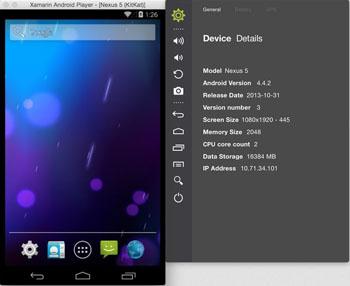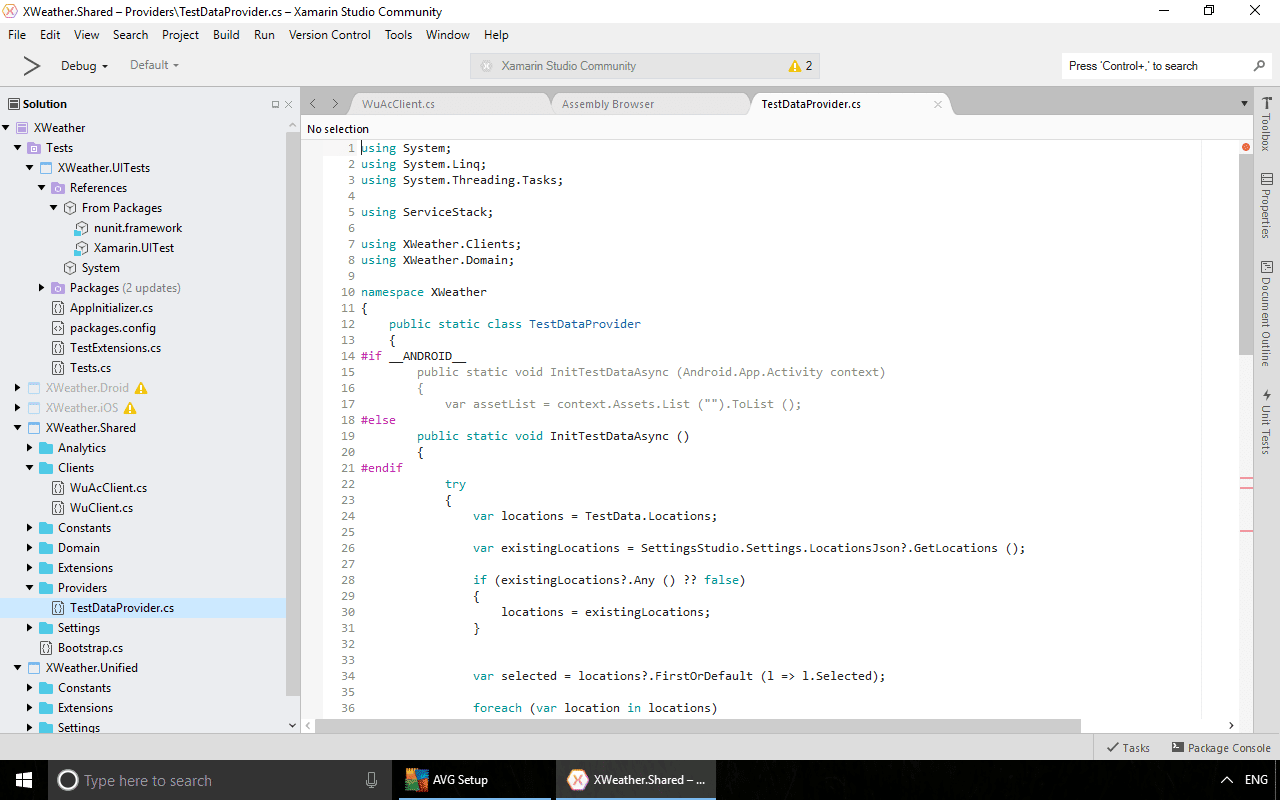- May 16, 2021 Instead, we will use a VLC media player in Xamarin Forms. Because VLC media player can be an awesome alternative to the native media players available in Android and iOS. These native players work well, but are limited and lack some important functionalities.
- We do not have a download file for the latest version (0.6.5), but you can try downloading it from the developer's site. Download version 0.3.7.2 from Software Informer. Scanned by 74 antivirus programs on Apr 13, 2021. The file is clean, see the report. Version: 0.3.7.2 (x86) Date update: Apr 24, 2015. File name: xamarinandroidplayerx32.exe.
- Xamarin Android Player has deep integration with Visual Studio and Xamarin Studio and a native user interface on both Mac & Windows. Running Android on an x86 virtual machine using hardware accelerated virtualization and OpenGL, Xamarin Android Player is significantly faster than the stock Android Emulator.
If you want to install Xamarin on Windows then go here. If you want to install Xamarin on Mac then watch the video below or scroll down to read the instructions.
Our Android Player is a high-speed hardware accelerated emulator, available on both Mac and PC, that integrates directly into Xamarin Studio and Visual Studio. Now, we’re exited to release a brand new update for the Android Player with several fixes and new features that will make developing Android apps even more enjoyable.
The instructions below are for the Mac operating system installing all components. You can also view the official Xamarin instructions on installing Xamarin on Mac and Windows here.

Step 1
Download Xamarin from xamarin.com/download and locate the installer file once it has downloaded.

Make sure if you are developing iOS apps that you also have Xcode installed on your Mac. You can download Xcode from developer.apple.com/xcode. It may already be installed on your Mac but make sure you have the latest version.

Step 2
Run the Xamarin installer and then double-click on the Xamarin icon to start the installation.
You may see an alert message like the one shown below. If you see the message below, click on Open.
Step 3
Review and accept the license to proceed with the installation. Check the box that says ‘I agree to the license terms‘ and then click on Continue.
Step 4
Now the installer will check if you already have any of the required components. It will then provide you with options to install any required components that are not already installed. Select the products you would like to install – this depends on what platforms you want to make native apps for.
If you want to make both Android and iOS apps, then select both Xamarin.Android and Xamarin.iOS. You can also select Mac if you want to develop Mac apps. Then click on Continue.
Step 5

If you have chosen to install Xamarin.Android then you will be notified that the Android SDK needs to install. Click on Continue.
You will then be shown all of the components that will be installed. Click on Continue to begin the installation.
Step 6
The Xamarin installer will begin downloading and installing the required components.
Hang around during the installation process because you may be asked to enter your password a few times to give permission to install the required components. Simply enter your password and click OK each time you see the message below.
Step 9
And you’re done! If you see the message below then Xamarin has successfully been installed on your computer. If something goes wrong or the installation fails, then you may see error messages (scroll down for more info). Once Xamarin has installed, you can run it from the Launchpad on your Mac.
There are a few reasons why the installation could fail but one of the most common reasons is that your computer runs out of available storage space during the installation. To fix this, make some more space available by deleting unwanted files and then try installing Xamarin again – don’t worry, you shouldn’t have to start downloading everything from the beginning, just what didn’t get downloaded.
The next thing you should do if you intend to make and test Android apps, is to download and install the Xamarin Android Player. It is much faster for testing your apps than the built-in Virtual Device Manager.
Next tutorial:Hello world! (in C#)
Xamarin Android Player Mac Free
-->Xamarin is an open-source platform for building modern and performant applications for iOS, Android, and Windows with .NET. Xamarin is an abstraction layer that manages communication of shared code with underlying platform code. Xamarin runs in a managed environment that provides conveniences such as memory allocation and garbage collection.
Xamarin enables developers to share an average of 90% of their application across platforms. This pattern allows developers to write all of their business logic in a single language (or reuse existing application code) but achieve native performance, look, and feel on each platform.
Xamarin applications can be written on PC or Mac and compile into native application packages, such as an .apk file on Android, or an .ipa file on iOS.
Note
Compiling and deploying applications for iOS currently requires a MacOS machine. For more information about development requirements, see system requirements.
Who Xamarin is for
Xamarin is for developers with the following goals:
- Share code, test and business logic across platforms.
- Write cross-platform applications in C# with Visual Studio.
How Xamarin works
The diagram shows the overall architecture of a cross-platform Xamarin application. Xamarin allows you to create native UI on each platform and write business logic in C# that is shared across platforms. In most cases, 80% of application code is sharable using Xamarin.
Xamarin is built on top of .NET, which automatically handles tasks such as memory allocation, garbage collection and interoperability with underlying platforms.
For more information about platform-specific architecture, see Xamarin.Android and Xamarin.iOS.
Added features
Xamarin combines the abilities of native platforms, while adding features that include:

- Complete binding for the underlying SDKs – Xamarin contains bindings for nearly the entire underlying platform SDKs in both iOS and Android. Additionally, these bindings are strongly-typed, which means that they’re easy to navigate and use, and provide robust compile-time type checking and during development. Strongly-typed bindings lead to fewer runtime errors and higher-quality applications.
- Objective-C, Java, C, and C++ Interop – Xamarin provides facilities for directly invoking Objective-C, Java, C, and C++ libraries, giving you the power to use a wide array of third party code. This functionality lets you use existing iOS and Android libraries written in Objective-C, Java, or C/C++. Additionally, Xamarin offers binding projects that allow you to bind native Objective-C and Java libraries using a declarative syntax.
- Modern language constructs – Xamarin applications are written in C#, a modern language that includes significant improvements over Objective-C and Java such as dynamic language features, functional constructs such as lambdas, LINQ, parallel programming, generics, and more.
- Robust Base Class Library (BCL) – Xamarin applications use the .NET BCL, a large collection of classes that have comprehensive and streamlined features such as powerful XML, Database, Serialization, IO, String, and Networking support, and more. Existing C# code can be compiled for use in an app, which provides access to thousands of libraries that add functionality beyond the BCL.
- Modern Integrated Development Environment (IDE) – Xamarin uses Visual Studio, a modern IDE that includes features such as code auto completion, a sophisticated project and solution management system, a comprehensive project template library, integrated source control, and more.
- Mobile cross-platform support – Xamarin offers sophisticated cross-platform support for the three major platforms of iOS, Android, and Windows. Applications can be written to share up to 90% of their code, and Xamarin.Essentials offers a unified API to access common resources across all three platforms. Shared code can significantly reduce both development costs and time to market for mobile developers.
Xamarin.Android
Xamarin.Android applications compile from C# into Intermediate Language (IL) which is then Just-in-Time (JIT) compiled to a native assembly when the application launches. Xamarin.Android applications run within the Mono execution environment, side by side with the Android Runtime (ART) virtual machine. Xamarin provides .NET bindings to the Android.* and Java.* namespaces. The Mono execution environment calls into these namespaces via Managed Callable Wrappers (MCW) and provides Android Callable Wrappers (ACW) to the ART, allowing both environments to invoke code in each other.
For more information, see Xamarin.Android architecture.
Xamarin.iOS
Xamarin.iOS applications are fully Ahead-of-Time (AOT) compiled from C# into native ARM assembly code. Xamarin uses Selectors to expose Objective-C to managed C# and Registrars to expose managed C# code to Objective-C. Selectors and Registrars collectively are called 'bindings' and allow Objective-C and C# to communicate.
For more information, see Xamarin.iOS architecture.
Xamarin.Essentials
Xamarin.Essentials is a library that provides cross-platform APIs for native device features. Like Xamarin itself, Xamarin.Essentials is an abstraction that simplifies the process of accessing native functionality. Some examples of functionality provided by Xamarin.Essentials include:
- Device info
- File system
- Accelerometer
- Phone dialer
- Text-to-speech
- Screen lock
For more information, see Xamarin.Essentials.
Xamarin.Forms
Duos-m Android Emulator
Xamarin.Forms is an open-source UI framework. Xamarin.Forms allows developers to build Xamarin.iOS, Xamarin.Android, and Windows applications from a single shared codebase. Xamarin.Forms allows developers to create user interfaces in XAML with code-behind in C#. These user interfaces are rendered as performant native controls on each platform. Some examples of features provided by Xamarin.Forms include:
- XAML user-interface language
- Databinding
- Gestures
- Effects
- Styling
For more information, see Xamarin.Forms.
Get started
The following guides will help you build your first app using Xamarin:
Related video
Leapdroid
Find more Xamarin videos on Channel 9 and YouTube.